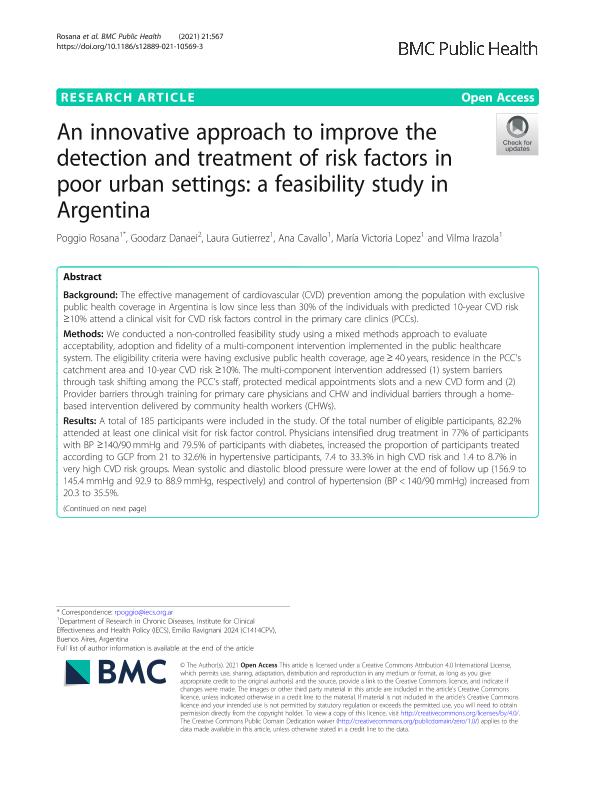Artículo
An innovative approach to improve the detection and treatment of risk factors in poor urban settings: a feasibility study in Argentina
Poggio, Rosana ; Danaei, Goodarz; Gutierrez, Laura; Cavallo, Ana; Lopez, María Victoria; Irazola, Vilma
; Danaei, Goodarz; Gutierrez, Laura; Cavallo, Ana; Lopez, María Victoria; Irazola, Vilma
 ; Danaei, Goodarz; Gutierrez, Laura; Cavallo, Ana; Lopez, María Victoria; Irazola, Vilma
; Danaei, Goodarz; Gutierrez, Laura; Cavallo, Ana; Lopez, María Victoria; Irazola, Vilma
Fecha de publicación:
03/2021
Editorial:
BioMed Central
Revista:
BMC Public Health
ISSN:
1471-2458
Idioma:
Inglés
Tipo de recurso:
Artículo publicado
Clasificación temática:
Resumen
Background: The effective management of cardiovascular (CVD) prevention among the population with exclusive public health coverage in Argentina is low since less than 30% of the individuals with predicted 10-year CVD risk ≥10% attend a clinical visit for CVD risk factors control in the primary care clinics (PCCs). Methods: We conducted a non-controlled feasibility study using a mixed methods approach to evaluate acceptability, adoption and fidelity of a multi-component intervention implemented in the public healthcare system. The eligibility criteria were having exclusive public health coverage, age ≥ 40 years, residence in the PCC’s catchment area and 10-year CVD risk ≥10%. The multi-component intervention addressed (1) system barriers through task shifting among the PCC’s staff, protected medical appointments slots and a new CVD form and (2) Provider barriers through training for primary care physicians and CHW and individual barriers through a home-based intervention delivered by community health workers (CHWs). Results: A total of 185 participants were included in the study. Of the total number of eligible participants, 82.2% attended at least one clinical visit for risk factor control. Physicians intensified drug treatment in 77% of participants with BP ≥140/90 mmHg and 79.5% of participants with diabetes, increased the proportion of participants treated according to GCP from 21 to 32.6% in hypertensive participants, 7.4 to 33.3% in high CVD risk and 1.4 to 8.7% in very high CVD risk groups. Mean systolic and diastolic blood pressure were lower at the end of follow up (156.9 to 145.4 mmHg and 92.9 to 88.9 mmHg, respectively) and control of hypertension (BP < 140/90 mmHg) increased from 20.3 to 35.5%. Conclusion: The proposed CHWs-led intervention was feasible and well accepted to improve the detection and treatment of risk factors in the poor population with exclusive public health coverage and with moderate or high CVD risk at the primary care setting in Argentina. Task sharing activities with CHWs did not only stimulate teamwork among PCC staff, but it also improved quality of care. This study showed that community health workers could have a more active role in the detection and clinical management of CVD risk factors in low-income communities.
Archivos asociados
Licencia
Identificadores
Colecciones
Articulos(CIESP)
Articulos de CENTRO DE INVESTIGACIONES EN EPIDEMIOLOGIA Y SALUD PUBLICA
Articulos de CENTRO DE INVESTIGACIONES EN EPIDEMIOLOGIA Y SALUD PUBLICA
Citación
Poggio, Rosana; Danaei, Goodarz; Gutierrez, Laura; Cavallo, Ana; Lopez, María Victoria; et al.; An innovative approach to improve the detection and treatment of risk factors in poor urban settings: a feasibility study in Argentina; BioMed Central; BMC Public Health; 21; 1; 3-2021; 1-11
Compartir
Altmétricas



